April is National Poetry Month and I can't let the month pass without sharing with you once again my very favorite gardening/farming poem. It speaks to me of the spirit of habitat gardening. I hope it speaks to you, too.
The Tuft of Flowers
by Robert Frost
I went to turn the grass once after one
Who mowed it in the dew before the sun.
The dew was gone that made his blade so keen
Before I came to view the levelled scene.
I looked for him behind an isle of trees;
I listened for his whetstone on the breeze.
But he had gone his way, the grass all mown,
And I must be, as he had been,--alone,
`As all must be,' I said within my heart,
`Whether they work together or apart.'
But as I said it, swift there passed me by
On noiseless wing a 'wildered butterfly,
Seeking with memories grown dim o'er night
Some resting flower of yesterday's delight.
And once I marked his flight go round and round,
As where some flower lay withering on the ground.
And then he flew as far as eye could see,
And then on tremulous wing came back to me.
I thought of questions that have no reply,
And would have turned to toss the grass to dry;
But he turned first, and led my eye to look
At a tall tuft of flowers beside a brook,
A leaping tongue of bloom the scythe had spared
Beside a reedy brook the scythe had bared.
I left my place to know them by their name,
Finding them butterfly weed when I came.
The mower in the dew had loved them thus,
By leaving them to flourish, not for us,
Nor yet to draw one thought of ours to him.
But from sheer morning gladness at the brim.
The butterfly and I had lit upon,
Nevertheless, a message from the dawn,
That made me hear the wakening birds around,
And hear his long scythe whispering to the ground,
And feel a spirit kindred to my own;
So that henceforth I worked no more alone;
But glad with him, I worked as with his aid,
And weary, sought at noon with him the shade;
And dreaming, as it were, held brotherly speech
With one whose thought I had not hoped to reach.
`Men work together,' I told him from the heart,
`Whether they work together or apart.'
Gardeners all over the world would agree with the sentiment expressed in those last two lines.
Welcome!
Welcome to my zone 9a habitat garden near Houston, Texas.
Friday, April 30, 2010
Wednesday, April 28, 2010
Tuesday, April 27, 2010
The great hibiscus mystery
Last summer, I purchased a pretty yellow hibiscus at my local Lowe's garden center.
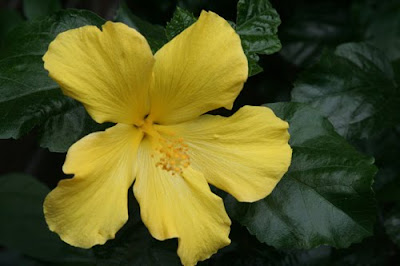.jpg)
The plant was very healthy and blooming when I bought it and it continued to bloom when I brought it home. All summer and autumn, it lived in a pot on the little patio near the entry to our house. It had an eastern exposure and received morning sun for a few hours but was shielded by the shadow of the house for much of the day.
It continued to be healthy and produced bloom after bloom, even forgiving me when I forgot to water it regularly. It was still in bloom when the first early freeze came on December 4. It was outside during that freeze and later dropped some of its leaves and stopped blooming, but it stayed green and kept a good number of leaves.
Belatedly, I took it and another hibiscus that I had kept on the patio into the garage for the winter. And there it stayed for many long weeks.
When the weather began to warm again, I brought it out into the sun. I had decided to put it into the ground in a new bed I had created on the south side of the house. The spot I had chosen for it was protected by the house on one side and the wooden fence on the other. I thought it should be able to withstand even quite cold weather in this location.
I planted it in the bed and almost immediately it started putting on new leaves and began to look like its old sturdy self once again. Last week, I noticed that it was covered in buds and I looked forward to seeing that first lovely yellow blossom this spring.
Imagine my surprise then when I walked through my garden gate this morning, glanced at the plant and saw this!

Who are you and what have you done with my yellow hibiscus???
Not only had the color changed but the bloom seemed smaller than last year as well. Now I know that some plants change the color of their blooms according to the Ph or other factors in the soil, hydrangeas being the prime example of that. But I had not heard that hibiscus plants could or would do that. Is that what happened here?
I turned to my old friend Google and, as usual, he had the answer for me.
It seems that there is an awful lot I didn't know about hibiscus blossoms and their color. They can change their color based on the soil, the weather, or the season of the year. Probably other factors as well. This is one whimsical plant!
So, I'm guessing that the fact that my plant suffered through a quite cold winter and then went from its safe little pot into the actual ground, and the weather was warmer, then cool again, then slowly warming after it was planted in the earth - all of these factors together, or perhaps any one of them, has caused the plant to change its color of bloom. As all those other buds on the plant begin to open, I will be very interested to see if they are all in this new color or if some of them revert to the old yellow or if perhaps some of them discover a new hue altogether. From what Google tells me almost anything is possible.
Meanwhile, on the other end of the bed where this hibiscus now lives, I planted another hibiscus from last year.

This one, too, spent the winter in its pot in the garage. It suffered some damage from that December freeze and is coming back slowly. It's nowhere near ready to bloom yet, but when it does, I wonder what color it will be? Yellow, maybe?
.jpg)
The plant was very healthy and blooming when I bought it and it continued to bloom when I brought it home. All summer and autumn, it lived in a pot on the little patio near the entry to our house. It had an eastern exposure and received morning sun for a few hours but was shielded by the shadow of the house for much of the day.
It continued to be healthy and produced bloom after bloom, even forgiving me when I forgot to water it regularly. It was still in bloom when the first early freeze came on December 4. It was outside during that freeze and later dropped some of its leaves and stopped blooming, but it stayed green and kept a good number of leaves.
Belatedly, I took it and another hibiscus that I had kept on the patio into the garage for the winter. And there it stayed for many long weeks.
When the weather began to warm again, I brought it out into the sun. I had decided to put it into the ground in a new bed I had created on the south side of the house. The spot I had chosen for it was protected by the house on one side and the wooden fence on the other. I thought it should be able to withstand even quite cold weather in this location.
I planted it in the bed and almost immediately it started putting on new leaves and began to look like its old sturdy self once again. Last week, I noticed that it was covered in buds and I looked forward to seeing that first lovely yellow blossom this spring.
Imagine my surprise then when I walked through my garden gate this morning, glanced at the plant and saw this!

Who are you and what have you done with my yellow hibiscus???
Not only had the color changed but the bloom seemed smaller than last year as well. Now I know that some plants change the color of their blooms according to the Ph or other factors in the soil, hydrangeas being the prime example of that. But I had not heard that hibiscus plants could or would do that. Is that what happened here?
I turned to my old friend Google and, as usual, he had the answer for me.
It seems that there is an awful lot I didn't know about hibiscus blossoms and their color. They can change their color based on the soil, the weather, or the season of the year. Probably other factors as well. This is one whimsical plant!
So, I'm guessing that the fact that my plant suffered through a quite cold winter and then went from its safe little pot into the actual ground, and the weather was warmer, then cool again, then slowly warming after it was planted in the earth - all of these factors together, or perhaps any one of them, has caused the plant to change its color of bloom. As all those other buds on the plant begin to open, I will be very interested to see if they are all in this new color or if some of them revert to the old yellow or if perhaps some of them discover a new hue altogether. From what Google tells me almost anything is possible.
Meanwhile, on the other end of the bed where this hibiscus now lives, I planted another hibiscus from last year.

This one, too, spent the winter in its pot in the garage. It suffered some damage from that December freeze and is coming back slowly. It's nowhere near ready to bloom yet, but when it does, I wonder what color it will be? Yellow, maybe?
Monday, April 26, 2010
Daylily season
I love daylilies. I know, I know. They are easy and common and no challenge at all. Well, I guess that's why I love them, because, as a gardener, I am lazy and common variety and I don't like plants that fight me.
For all those reasons, I have lots of daylilies in my yard and I just added several more this spring, so I am looking forward to a big season of daylily blooms this year. It has already started. This past weekend, I had my first daylily bloom of the season.

This lemon yellow bloomer is always my first daylily bloom every year. I've had it for several years and divided it and moved it all around the yard, so that, now, I'm no longer even sure what its name is. But I have a weakness for yellow blossoms of all kinds, so I'm always particularly happy to welcome this one.
Several other daylilies around the yard have developed buds. May promises to be a very colorful month in my garden.
For all those reasons, I have lots of daylilies in my yard and I just added several more this spring, so I am looking forward to a big season of daylily blooms this year. It has already started. This past weekend, I had my first daylily bloom of the season.

This lemon yellow bloomer is always my first daylily bloom every year. I've had it for several years and divided it and moved it all around the yard, so that, now, I'm no longer even sure what its name is. But I have a weakness for yellow blossoms of all kinds, so I'm always particularly happy to welcome this one.
Several other daylilies around the yard have developed buds. May promises to be a very colorful month in my garden.
Friday, April 23, 2010
A Friday stroll through my garden
What's the use of having a garden if you can't stop occasionally and enjoy it?
I had a busy day of gardening today and I barely even scratched the surface of what needs to be done, but that's what tomorrow is for. Today, I decided to stop for a bit and take a stroll through the garden to see what I could see. I took the camera with me.
A few years ago, when I was about to add some roses to the garden, I offered my younger daughter the opportunity to pick one variety to add. This is the one she chose.

It is 'American Beauty.' I think she was taken with the name more than the rose itself. Maybe she had just seen the movie by that name. For whatever reason, this is what she chose. It would not have been my choice probably, but, oh well... We sent our order off to Antique Rose Emporium and then planted the rose bush and waited. For the first three or four years of its life, it didn't do much for us, and finally I moved it to an out-of-the-way bed next to the garden shed. It seems to like that spot. It bloomed well last year and this spring it has been absolutely glorious. Maybe Sarah didn't make such a bad choice, after all.

This is what the blossoms look like, close up. They also have a nice fragrance. My mother used to grow this rose when I was little so I have good memories of it.

As I walked around the garden, I saw this anole displaying on the veggie garden fence. I tried to get a picture of him with his red throat pouch expanded, but he wouldn't cooperate. Then he caught a bug and stopped to have a snack. No more displaying for a while!

The 'Early Sunrise' coreopsis has started its bloom.

So, too, finally, have the amaryllis.

'Apple Blossom' amaryllis is several weeks later than last year, but who's complaining? I'm just happy to see these wonderful blooms.
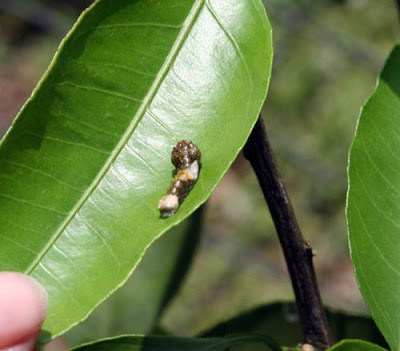
And here's a very different kind of beauty! This is the caterpillar of the Giant Swallowtail butterfly. Can you see why it is called the 'bird dropping' caterpillar? This one is very new. That's my thumbnail on the corner of the leaf, so you can judge the size of the larva.

Here's a second caterpillar. There may have been more but two were all I saw. I hope they do not attract the attention of the wasps as, unfortunately, my Monarch caterpillars did. But these guys are very well disguised. I'm not sure that even a wasp would be interested in a bird dropping.

On a trellis next to the garden gate, the Mexican flame vine shows how it got its name.

Near the vine, this heliotrope provides a bright counterpoint of color.

Through the garden gate and into the front yard, the bed at the entry of the house is beginning to fill in nicely. Those two taller plants in the back are Texas Star Hibiscus on the left and 'Fourth of July' buddleia on the right. The hibiscus has come back strongly from last year, as has the buddleia. This buddleia bloomed beautifully for me last year, all summer and fall, right up to the first frost.

At the post "bird" feeder in the front yard, three rather furry "birds" settle down for a snack.
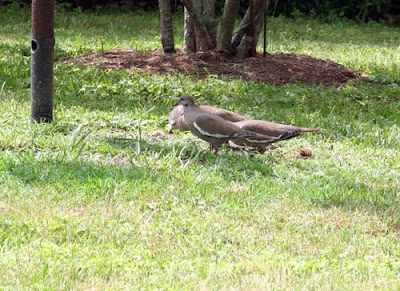
While at the backyard feeder where squirrels are forbidden, the White-winged Doves reign.

This purple verbena never completely went down during the winter and was one of my first plants to come back into bloom this spring.

'Graham Thomas' didn't get in any hurry at all to give me that first bloom, but I guess he's worth waiting for.

Yes, he's definitely worth waiting for.

Not to be outdone, in the backyard, 'Dortmund' has been putting on a nice show.

'Yesterday, Today, and Tomorrow' also is showing us some color.

I love the 'Red Cascade' with its miniature red roses. It is full of buds but so far has shown only a few blossoms.
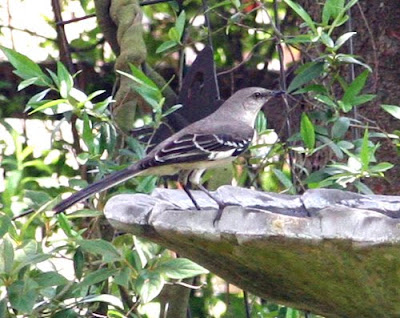
The backyard birdbath was a popular spot today, especially with this mockingbird. Taking care of a nest full of babies is hard and thirsty work!

Leave it to a Blue Jay, though, to know what a birdBATH is really for!

I love the way this Mexican feather grass in the bottletree bed moves in the wind.

After a hard morning of gardening, it's time for a catnap in the shade! I know just how Nicholas feels.
I had a busy day of gardening today and I barely even scratched the surface of what needs to be done, but that's what tomorrow is for. Today, I decided to stop for a bit and take a stroll through the garden to see what I could see. I took the camera with me.
A few years ago, when I was about to add some roses to the garden, I offered my younger daughter the opportunity to pick one variety to add. This is the one she chose.

It is 'American Beauty.' I think she was taken with the name more than the rose itself. Maybe she had just seen the movie by that name. For whatever reason, this is what she chose. It would not have been my choice probably, but, oh well... We sent our order off to Antique Rose Emporium and then planted the rose bush and waited. For the first three or four years of its life, it didn't do much for us, and finally I moved it to an out-of-the-way bed next to the garden shed. It seems to like that spot. It bloomed well last year and this spring it has been absolutely glorious. Maybe Sarah didn't make such a bad choice, after all.

This is what the blossoms look like, close up. They also have a nice fragrance. My mother used to grow this rose when I was little so I have good memories of it.

As I walked around the garden, I saw this anole displaying on the veggie garden fence. I tried to get a picture of him with his red throat pouch expanded, but he wouldn't cooperate. Then he caught a bug and stopped to have a snack. No more displaying for a while!

The 'Early Sunrise' coreopsis has started its bloom.

So, too, finally, have the amaryllis.

'Apple Blossom' amaryllis is several weeks later than last year, but who's complaining? I'm just happy to see these wonderful blooms.

And here's a very different kind of beauty! This is the caterpillar of the Giant Swallowtail butterfly. Can you see why it is called the 'bird dropping' caterpillar? This one is very new. That's my thumbnail on the corner of the leaf, so you can judge the size of the larva.

Here's a second caterpillar. There may have been more but two were all I saw. I hope they do not attract the attention of the wasps as, unfortunately, my Monarch caterpillars did. But these guys are very well disguised. I'm not sure that even a wasp would be interested in a bird dropping.

On a trellis next to the garden gate, the Mexican flame vine shows how it got its name.

Near the vine, this heliotrope provides a bright counterpoint of color.

Through the garden gate and into the front yard, the bed at the entry of the house is beginning to fill in nicely. Those two taller plants in the back are Texas Star Hibiscus on the left and 'Fourth of July' buddleia on the right. The hibiscus has come back strongly from last year, as has the buddleia. This buddleia bloomed beautifully for me last year, all summer and fall, right up to the first frost.

At the post "bird" feeder in the front yard, three rather furry "birds" settle down for a snack.

While at the backyard feeder where squirrels are forbidden, the White-winged Doves reign.

This purple verbena never completely went down during the winter and was one of my first plants to come back into bloom this spring.

'Graham Thomas' didn't get in any hurry at all to give me that first bloom, but I guess he's worth waiting for.

Yes, he's definitely worth waiting for.

Not to be outdone, in the backyard, 'Dortmund' has been putting on a nice show.

'Yesterday, Today, and Tomorrow' also is showing us some color.

I love the 'Red Cascade' with its miniature red roses. It is full of buds but so far has shown only a few blossoms.

The backyard birdbath was a popular spot today, especially with this mockingbird. Taking care of a nest full of babies is hard and thirsty work!

Leave it to a Blue Jay, though, to know what a birdBATH is really for!

I love the way this Mexican feather grass in the bottletree bed moves in the wind.

After a hard morning of gardening, it's time for a catnap in the shade! I know just how Nicholas feels.
Thursday, April 22, 2010
Happy Earth Day! Or how to save the planet in ten easy steps.

Happy Earth Day!
In the spirit of the day, here are ten ways that gardeners can save our planet:
1. Eschew chemicals. Too many of the chemical fertilizers, pesticides, and herbicides used by gardeners and farmers wind up in our water supply to the detriment of the environment and of our health. Everything that you use a chemical for has an environmentally safe and effective organic counterpart. Find out what they are and use them.
2. Use native plants in your landscape whenever feasible. These tough plants are acclimated to anything that Mother Nature is likely to throw at them here; moreover, they have evolved with our native wildlife and are more likely to be utilized by them.
3. Invite helpful wildlife into your garden. One way, of course, is to plant native plants, but wildlife need three things to survive: food, water, and shelter. If you can provide those things, your yard will soon be teeming with bees, butterflies, birds, spiders, lizards, frogs, toads, and, yes, even snakes. They are all the gardener's friends.
4. Harvest rainwater. As water becomes a scarcer commodity in our environment, it is important that we not let this valuable resource go to waste. Rain barrels, bog gardens, and other features that trap and use rain are becoming more popular, as well they should. Climb onto the bandwagon!
5. Use plants that require less water. Practice xeric gardening and water plants only when needed.
6. Use drip irrigation where possible. If you have a sprinkler system, for heaven's sake, use common sense about it. How wasteful it is to have sprinklers watering the sidewalks or to have them running during a rainstorm!
7. Grow at least some of your own food. Even if it is only one pepper or tomato plant, there is nothing that tastes better than food you have grown yourself. Plus, you have the advantage of controlling what goes into the production of that food, and growing it will give you an enhanced respect for the Earth and her processes.
8. Recycle whenever possible. Don't add unnecessarily to the piles of trash which must be disposed of. Start a compost pile and compost everything that you can. Find new uses for old or found objects. Many times, these can be used in the garden in various ways, even as garden ornaments.
9. Mulch. A thick layer of mulch is one of the nicest things you can do for your plants and for the Earth. It conserves moisture, ameliorates extremes in temperatures, and gradually add nutrients to the soil - which is the best way to add nutrients to the soil.
10. Support local growers, farmers' markets, and other local gardening organizations. And spread the word and the enthusiasm about gardening whenever you get the chance, particularly with young people. It has been said that kids today suffer from "Nature Deficit Disorder." There are few more effective cures for that malady than to get them interested and involved in gardening.
Lastly, think globally but act locally. Do your bit on your own little patch of the Earth and you'll be helping to save the planet.
Tuesday, April 20, 2010
Can't beet them!
This is my week to try to finish up planting the vegetable garden. Yes, I know I'm a bit late. I kept encountering delays along the way.
I've just finally planted my zucchini and yellow squash and my cucumbers this week. Yesterday, I also planted a bed of sunflowers. I can't have a garden without sunflowers! I may add one or two more things - definitely a few more herbs, now that I've pulled out some of my cold weather herbs - but the veggie garden is now essentially complete.
My Russian banana fingerling potatoes that were planted in January and took forever to come up are looking great now. The tomatoes, peppers, and eggplants look good, too, although still a bit small because they were planted late. My haricot vert bush beans are coming along like gangbusters and the corn is looking - well, not that great actually, but I'm working on that. I'm still harvesting carrots from my fall crop and I have a late spring crop now coming along. Can't be without carrots.
Yesterday, in addition to planting, I also harvested. Before I could plant my sunflowers, I had to clear out the beet bed. It was time for them to be harvested anyway. They had been in the ground since late fall. They were surprised by the early freeze and then the continuing cold weather kept them small for several weeks, but they came through it all just fine and finally produced the nice roots for which they are famous.
When I pulled them all from the ground and cut off the tops leaving about an inch or so of the greens, I had a nice full basket of nutrient rich veggies. Now what?
I like beets most any way they can be prepared. They make wonderful soup (borscht) or can be simply sliced and boiled or baked as a side dish. I even found, when I did an Internet search, that there is a beet cake! When I mentioned that to Bob, he looked at me as if I had lost my mind, and when I thought about it, the whole concept just seemed wrong to me. So, no beet cake for us.
Then, of course, there are beet pickles. My family is particularly fond of beet pickles, and so was there ever really any doubt as to how my beets would be prepared? Beet pickles it would be!
The only problem was that by the time I got around to cleaning the beets, I was too pooped to pickle. I washed them and put them on the stove to boil in some water. After they were tender and cooled, I removed their skins and put them in a big plastic tub in the refrigerator to wait until I was rested and had time to deal with them.
That time was not to come today. I had a couple of appointments that took me away from the house, but if all goes well, tomorrow afternoon my beets and I have a date, and there shall be pickles!
Should you ever want to raise your own beets and follow my pickling example, my advice, if you live in my part of the world, is to plant them in the fall. They prefer to grow in cool weather. Once they are ready, here is your pickle recipe. This recipe will yield 10 pint jars of pickles. You can easily adjust it to fit the quantity of beets that you have.
Ingredients
•10 pounds fresh small beets, stems removed
•2 cups white sugar
•1 tablespoon pickling salt
•1 quart white vinegar
•1/4 cup whole cloves
Directions
•Place beets in a large stockpot with water to cover. Bring to a boil, and cook until tender, about 15 minutes depending on the size of the beets. If beets are large, cut them into quarters. Drain, reserving 2 cups of the beet water, cool and peel.
•Sterilize jars and lids by immersing in boiling water for at least 10 minutes. Fill each jar with beets and add several whole cloves to each jar.
•In a large saucepan, combine the sugar, beet water, vinegar, and pickling salt. Bring to a rapid boil. Pour the hot brine over the beets in the jars, and seal lids.
•Place a rack in the bottom of a large stockpot and fill halfway with water. Bring to a boil over high heat, then carefully lower the jars into the pot using a holder. Leave a 2 inch space between the jars. Pour in more boiling water if necessary until the water level is at least 1 inch above the tops of the jars. Bring the water to a full boil, cover the pot, and process for 10 minutes.
One word of advice: Before pouring the brine over the beets, taste it and make sure that it is not either too sour or too sweet for your taste. At this point, you can adjust it if needed. Also, some people, myself included, like to add a cinnamon stick to each jar, or you can add other spices according to your own taste. The point is to play with it and make it your own recipe. Finally, you'll come up with a taste that you just can't beet - er - beat. Happy pickling!
I've just finally planted my zucchini and yellow squash and my cucumbers this week. Yesterday, I also planted a bed of sunflowers. I can't have a garden without sunflowers! I may add one or two more things - definitely a few more herbs, now that I've pulled out some of my cold weather herbs - but the veggie garden is now essentially complete.
My Russian banana fingerling potatoes that were planted in January and took forever to come up are looking great now. The tomatoes, peppers, and eggplants look good, too, although still a bit small because they were planted late. My haricot vert bush beans are coming along like gangbusters and the corn is looking - well, not that great actually, but I'm working on that. I'm still harvesting carrots from my fall crop and I have a late spring crop now coming along. Can't be without carrots.
Yesterday, in addition to planting, I also harvested. Before I could plant my sunflowers, I had to clear out the beet bed. It was time for them to be harvested anyway. They had been in the ground since late fall. They were surprised by the early freeze and then the continuing cold weather kept them small for several weeks, but they came through it all just fine and finally produced the nice roots for which they are famous.
When I pulled them all from the ground and cut off the tops leaving about an inch or so of the greens, I had a nice full basket of nutrient rich veggies. Now what?
I like beets most any way they can be prepared. They make wonderful soup (borscht) or can be simply sliced and boiled or baked as a side dish. I even found, when I did an Internet search, that there is a beet cake! When I mentioned that to Bob, he looked at me as if I had lost my mind, and when I thought about it, the whole concept just seemed wrong to me. So, no beet cake for us.
Then, of course, there are beet pickles. My family is particularly fond of beet pickles, and so was there ever really any doubt as to how my beets would be prepared? Beet pickles it would be!
The only problem was that by the time I got around to cleaning the beets, I was too pooped to pickle. I washed them and put them on the stove to boil in some water. After they were tender and cooled, I removed their skins and put them in a big plastic tub in the refrigerator to wait until I was rested and had time to deal with them.
That time was not to come today. I had a couple of appointments that took me away from the house, but if all goes well, tomorrow afternoon my beets and I have a date, and there shall be pickles!
Should you ever want to raise your own beets and follow my pickling example, my advice, if you live in my part of the world, is to plant them in the fall. They prefer to grow in cool weather. Once they are ready, here is your pickle recipe. This recipe will yield 10 pint jars of pickles. You can easily adjust it to fit the quantity of beets that you have.
Ingredients
•10 pounds fresh small beets, stems removed
•2 cups white sugar
•1 tablespoon pickling salt
•1 quart white vinegar
•1/4 cup whole cloves
Directions
•Place beets in a large stockpot with water to cover. Bring to a boil, and cook until tender, about 15 minutes depending on the size of the beets. If beets are large, cut them into quarters. Drain, reserving 2 cups of the beet water, cool and peel.
•Sterilize jars and lids by immersing in boiling water for at least 10 minutes. Fill each jar with beets and add several whole cloves to each jar.
•In a large saucepan, combine the sugar, beet water, vinegar, and pickling salt. Bring to a rapid boil. Pour the hot brine over the beets in the jars, and seal lids.
•Place a rack in the bottom of a large stockpot and fill halfway with water. Bring to a boil over high heat, then carefully lower the jars into the pot using a holder. Leave a 2 inch space between the jars. Pour in more boiling water if necessary until the water level is at least 1 inch above the tops of the jars. Bring the water to a full boil, cover the pot, and process for 10 minutes.
One word of advice: Before pouring the brine over the beets, taste it and make sure that it is not either too sour or too sweet for your taste. At this point, you can adjust it if needed. Also, some people, myself included, like to add a cinnamon stick to each jar, or you can add other spices according to your own taste. The point is to play with it and make it your own recipe. Finally, you'll come up with a taste that you just can't beet - er - beat. Happy pickling!
Sunday, April 18, 2010
Snakes in the grass - and on the porch
I went to the back porch a couple of days ago to retrieve my cat, Nicholas, who had been helping me with my garden work outside. Nicholas is a great gardener - especially good at digging holes and filling them - but he truly excels at every gardener's favorite activity in the yard, resting in the shade, preferably on his back while he airs his tummy fur.
Anyway, as I say, I went to retrieve my gardening assistant and found him in a face-off on the porch with this guy:
 The snake had been herded into a corner near the back door and had no escape route. As I looked at him from the doorway, he raised his head toward me and shook the tip of his tail. "Nice try," I thought, "but I know you are not a rattlesnake!"
The snake had been herded into a corner near the back door and had no escape route. As I looked at him from the doorway, he raised his head toward me and shook the tip of his tail. "Nice try," I thought, "but I know you are not a rattlesnake!"
But what was he? I'm not good at identifying snakes, so I wanted to get my camera to take a picture so that I might identify him later. Since neither snake nor cat seemed to be in any eminent danger and the snake did not appear particularly aggressive, I shut the door and ran for the camera and took the shot that you see above. The only thing left to do was to distract Nicholas so the snake could escape, not a difficult task as my cat is more a lover than a fighter.
Mission accomplished and snake on his way, I uploaded the picture and pored over my Peterson Field Gudes' Reptiles and Amphibians of Eastern/Central North America. Sure enough, there was my snake in plate 28, "Rat Snakes." There are several different kinds of rat snakes, but my visitor was a Texas rat snake.
I was excited to have seen this snake. When I'm digging around the yard, I often encounter small snakes, which is gratifying, but this was a pretty big snake. Since it was coiled, it was difficult to estimate its length, but I would guess at least four or five feet, and it looked very well fed.
Researching the Texas rat snake, I found that they are very well-named. Their chief prey is rodents. We have had some problems with rodents in the past, particularly when we kept chickens, but I haven't seen any around the yard - except for moles - in more than a year. Hey, maybe that's because my resident snake has been on the job!
At any rate, finding this snake made me happy. I am a habitat gardener, after all, and snakes are an important and often persecuted part of the natural environment. It is important to me that they find a safe haven in my yard. It looks like this one has.
(Read more about this very interesting and useful snake here.)
Anyway, as I say, I went to retrieve my gardening assistant and found him in a face-off on the porch with this guy:
 The snake had been herded into a corner near the back door and had no escape route. As I looked at him from the doorway, he raised his head toward me and shook the tip of his tail. "Nice try," I thought, "but I know you are not a rattlesnake!"
The snake had been herded into a corner near the back door and had no escape route. As I looked at him from the doorway, he raised his head toward me and shook the tip of his tail. "Nice try," I thought, "but I know you are not a rattlesnake!"But what was he? I'm not good at identifying snakes, so I wanted to get my camera to take a picture so that I might identify him later. Since neither snake nor cat seemed to be in any eminent danger and the snake did not appear particularly aggressive, I shut the door and ran for the camera and took the shot that you see above. The only thing left to do was to distract Nicholas so the snake could escape, not a difficult task as my cat is more a lover than a fighter.
Mission accomplished and snake on his way, I uploaded the picture and pored over my Peterson Field Gudes' Reptiles and Amphibians of Eastern/Central North America. Sure enough, there was my snake in plate 28, "Rat Snakes." There are several different kinds of rat snakes, but my visitor was a Texas rat snake.
I was excited to have seen this snake. When I'm digging around the yard, I often encounter small snakes, which is gratifying, but this was a pretty big snake. Since it was coiled, it was difficult to estimate its length, but I would guess at least four or five feet, and it looked very well fed.
Researching the Texas rat snake, I found that they are very well-named. Their chief prey is rodents. We have had some problems with rodents in the past, particularly when we kept chickens, but I haven't seen any around the yard - except for moles - in more than a year. Hey, maybe that's because my resident snake has been on the job!
At any rate, finding this snake made me happy. I am a habitat gardener, after all, and snakes are an important and often persecuted part of the natural environment. It is important to me that they find a safe haven in my yard. It looks like this one has.
(Read more about this very interesting and useful snake here.)
Thursday, April 15, 2010
Garden Bloggers' Bloom Day: April 2010
It is said that "April showers bring May flowers" and, if that is true, our May flowers may be a bit sparse this year for April has been dry in my yard. I looked back at my 10-year garden journal for last April and found that it was a very wet month. What a difference a year makes.
Oh, well, never mind. Why worry about May flowers when we've got plenty of April flowers to look at? As usual, Carol of May Dreams Garden is hosting Garden Bloggers' Bloom Day where you can find extensive links to gardeners all around the country who are showing off their bloomers today.
But wait! Before you rush off to look at those gardens, let me show you some of the things that I've got blooming this month.

Okay, this is Texas, so let's get the obligatory April bluebonnet out of the way right up front! Haven't these beauties been glorious this spring? Even in my little wildflower bed in the backyard, they have put on quite a show.

"Belinda" has awakened from her "Dream" and is gracing my garden with the luscious blossoms for which she is famous.

Worshipping at her feet, the purple oxalis is just trying to keep up.
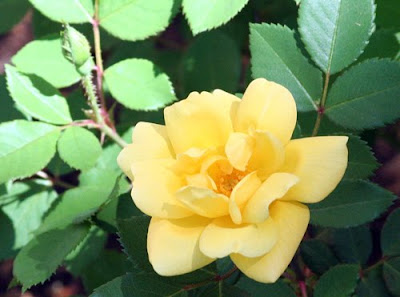
The 'Radsunny' Knockouts were a disappointment in my garden last year, their first year here. I moved them during the winter, seeking a spot where they might be happier and they have responded magnificently. They've been absolutely glorious this spring.

I even like the way the 'Radsunny' ages, from the bright yellow of its first blush to this creamy yellow a few days later.

'Rouge Cardinal' clematis has been the star all month on the trellis next to the back porch.
 My Satsuma has put on a nice display of blooms. Does that mean that I might actually get more than one fruit from it this year?
My Satsuma has put on a nice display of blooms. Does that mean that I might actually get more than one fruit from it this year?

The Dutch irises have been particularly nice this spring. If I can't have the bearded iris that I crave, these are not a bad substitute. I especially like this yellow one.
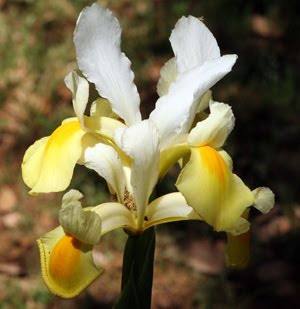
But the white and yellow one isn't bad either.

These 'Tangerine Dream' crossvine blossoms seem lit from within. This vine doesn't have much to recommend it for much of the year, but when it is in bloom - oh, my!
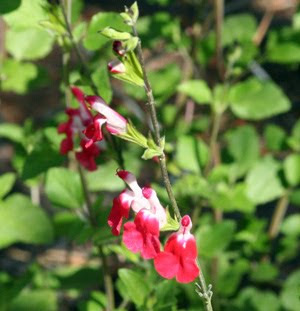
'Hot Lips' salvia has joined the spring fling.

In fact, Salvia greggiis all over the yard are bursting into bloom.

This little double dianthus, the name of which is lost to me, brightens one of my favorite sitting areas in the yard, along with her Talavera hen planter.

'Dortmund's" back and I am so glad!
 The variegated potato vine doesn't seem to be as floriferous as its all-green cousin, but it brightens this otherwise rather drab corner of the yard.
The variegated potato vine doesn't seem to be as floriferous as its all-green cousin, but it brightens this otherwise rather drab corner of the yard.
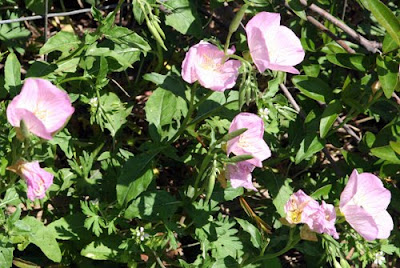
The unconquerable evening primrose. Some of them always elude the mowers along the veggie garden fence and I'm glad they do.

The 'Emerald Snow' loropetalum has been in bloom since I brought it home from Mercer's March Mart.

Coral honeysuckle, a disappointment last year, is making up for lost time this spring.
 At the honeysuckle's feet, this little osteospermum offers its happy blooms.
At the honeysuckle's feet, this little osteospermum offers its happy blooms.
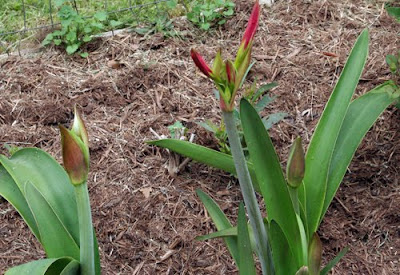
Meantime, in another part of the yard, the amaryllis blooms are late coming this year.

While the blueberries have long since finished their bloom and have moved on to the fruiting stage of their development.

Dependable 'Radazz' Knockout does its thing. Knockouts may no longer be one of the "in" plants, but then I'm not one of the "in" gardeners and I still love them.
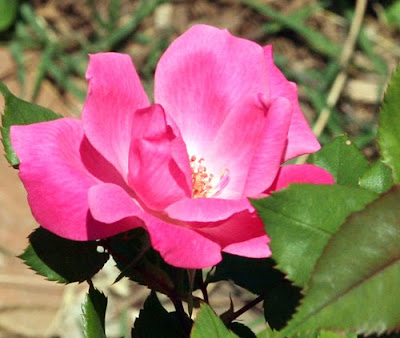
In fact, I like them so much I have them in several shades - including this pink one.

No blooms here but the little Japanese maples still manage to bring color to their part of the garden.

'Hinckley's columbine,' in its first season in my garden, is performing nicely for me.

But 'Graham Thomas' continues to titillate me with these half-opened buds. Oh, Graham, you are such a tease! When will you relent and satisfy my desire for your luscious blossoms?

See, Graham? Even a "lawn" can do it!
Oh, well, never mind. Why worry about May flowers when we've got plenty of April flowers to look at? As usual, Carol of May Dreams Garden is hosting Garden Bloggers' Bloom Day where you can find extensive links to gardeners all around the country who are showing off their bloomers today.
But wait! Before you rush off to look at those gardens, let me show you some of the things that I've got blooming this month.

Okay, this is Texas, so let's get the obligatory April bluebonnet out of the way right up front! Haven't these beauties been glorious this spring? Even in my little wildflower bed in the backyard, they have put on quite a show.

"Belinda" has awakened from her "Dream" and is gracing my garden with the luscious blossoms for which she is famous.

Worshipping at her feet, the purple oxalis is just trying to keep up.

The 'Radsunny' Knockouts were a disappointment in my garden last year, their first year here. I moved them during the winter, seeking a spot where they might be happier and they have responded magnificently. They've been absolutely glorious this spring.

I even like the way the 'Radsunny' ages, from the bright yellow of its first blush to this creamy yellow a few days later.

'Rouge Cardinal' clematis has been the star all month on the trellis next to the back porch.
 My Satsuma has put on a nice display of blooms. Does that mean that I might actually get more than one fruit from it this year?
My Satsuma has put on a nice display of blooms. Does that mean that I might actually get more than one fruit from it this year? 
The Dutch irises have been particularly nice this spring. If I can't have the bearded iris that I crave, these are not a bad substitute. I especially like this yellow one.

But the white and yellow one isn't bad either.

These 'Tangerine Dream' crossvine blossoms seem lit from within. This vine doesn't have much to recommend it for much of the year, but when it is in bloom - oh, my!

'Hot Lips' salvia has joined the spring fling.

In fact, Salvia greggiis all over the yard are bursting into bloom.

This little double dianthus, the name of which is lost to me, brightens one of my favorite sitting areas in the yard, along with her Talavera hen planter.

'Dortmund's" back and I am so glad!
 The variegated potato vine doesn't seem to be as floriferous as its all-green cousin, but it brightens this otherwise rather drab corner of the yard.
The variegated potato vine doesn't seem to be as floriferous as its all-green cousin, but it brightens this otherwise rather drab corner of the yard.
The unconquerable evening primrose. Some of them always elude the mowers along the veggie garden fence and I'm glad they do.

The 'Emerald Snow' loropetalum has been in bloom since I brought it home from Mercer's March Mart.

Coral honeysuckle, a disappointment last year, is making up for lost time this spring.
 At the honeysuckle's feet, this little osteospermum offers its happy blooms.
At the honeysuckle's feet, this little osteospermum offers its happy blooms. 
Meantime, in another part of the yard, the amaryllis blooms are late coming this year.

While the blueberries have long since finished their bloom and have moved on to the fruiting stage of their development.

Dependable 'Radazz' Knockout does its thing. Knockouts may no longer be one of the "in" plants, but then I'm not one of the "in" gardeners and I still love them.

In fact, I like them so much I have them in several shades - including this pink one.

No blooms here but the little Japanese maples still manage to bring color to their part of the garden.

'Hinckley's columbine,' in its first season in my garden, is performing nicely for me.

But 'Graham Thomas' continues to titillate me with these half-opened buds. Oh, Graham, you are such a tease! When will you relent and satisfy my desire for your luscious blossoms?

See, Graham? Even a "lawn" can do it!
Subscribe to:
Posts (Atom)
